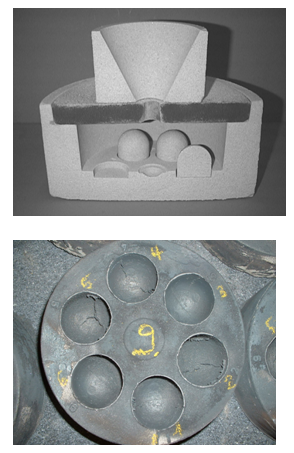Dome core test
Casting experiments in dome core molds are performed in order to assess the formation of veining in different core molding materials with and without additives (Fig. 1).
To do so, dome cores are made from the various sand mixtures to be tested and glued into a corresponding mold (Fig. 1, top). After casting, the resulting surface can then be evaluated (Fig. 1, bottom).
The expansion of mold materials or mold parts during casting and solidification is a crucial cause of numerous imperfections in castings. They are summarized by the term “sand expansion defects”. The effect of heat (radiation, thermal conduction) from the inflowing metal causes the thermal expansion of the mold material (sand expansion). As a consequence, considerable tensional differences occur due to temperature differences in the individual zones of the mold part.
If the thermo-mechanical strain (tensions) exceeds the deformability and tensile strength in the strain cross-section and if the casting metal is ductile enough to reach the fine cracks, this results in various casting imperfections (hot cracks, scab, veining, etc.).


